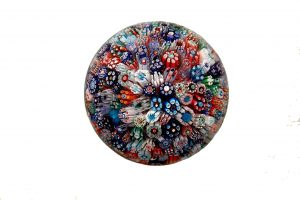Millefiori Paperweight - German/German

This very rare millefiori paperweight from around 1840 is a classic. It is one of the five earliest millefiori paperweights known to date. In 1833, Dr. Wilhelm Eduard Fuß at the glassworks in Hoffnungsthal in the Silesian Riesengebirge succeeded in reconstructing the lost method of making millefiori from Roman times. From 1836, Italian glassmakers in Murano near Venice also redeveloped the old millefiori technique.
Millefiori paperweights, from the Italian "mille fiori" - "thousand flowers", are paperweights in which multi-coloured glass rods are cut into slices. These so-called "canes" are placed in shapes to form certain patterns: concentric circles or colourful flower meadows. In contrast to such arranged millefiori paperweights, the patterns are created in scrambled, end-of-day or after-work paperweights. Here, disordered whole or broken millefiori discs, latticinio or filigree sticks or coloured ribbons left over after the end of work are used.
Millefiori Paperweight - English

This extremely rare Millefiori paperweight dating from around 1840 is a classic and is one of five of the earliest Millefiori paperweights known today. In 1833 Dr. Wilhelm Eduard Fuß managed to reconstruct the since forgotten Roman Millefiori production method in a glass foundry in the Silesian Giant Mountains. Italian glassmakers in Murano near Venice also re-invented Millefiori technique in 1836.
Millefiori paperweights, from the Italian "mille fiori" meaning "a thousand flowers," contain the many-coloured canes cut into slices and arranged in specific designs such as concentric circles or colourful fields of flowers. These ordered designs stand in contrast to the scrambled "end-of-day," paperweights that contain random whole or broken millefiori slices, latticinio or filigree rods, or coloured strips that remain at the end of a day's work.